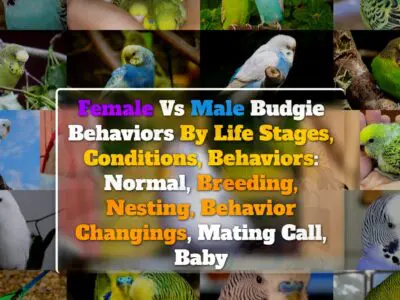Let’s say you’re a budgie enthusiast, with a keen interest in these small, colorful parrots.
One of the most intriguing aspects of budgie anatomy that has piqued your interest is their cere – the colorful, fleshy area above their beak where the nostrils are located.
I’m here to provide comprehensive information about the importance, colors, changes, and conditions affecting a budgie’s cere.
A budgie’s cere color and shape are key to understanding their sex, age, and health.
Male budgies usually have a blue cere, females a white or brown one.
Changes in these characteristics may signal health problems or breeding readiness.
What Is A Cere In Budgies?
Just like humans, every part of a budgie’s body serves a purpose and the cere is no different.
When you look at your budgie’s face, the area just above the beak that contains the nostrils is called the cere.
It’s a fleshy, usually colorful area that often gives away the budgie’s gender, age, and health status.
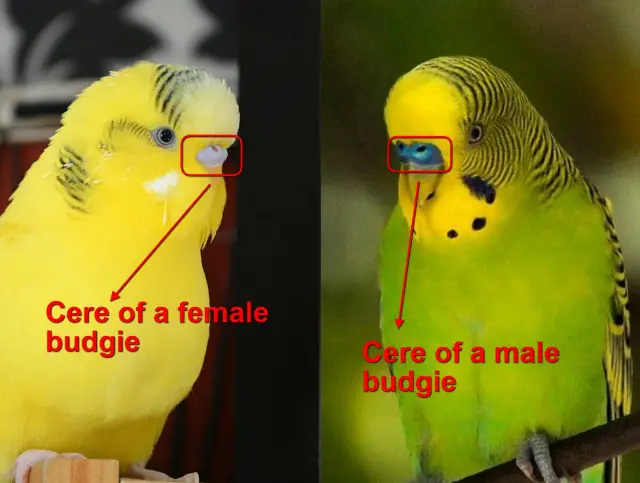
Why Is Cere Important In Budgies?
The cere of a budgie holds great significance.
A budgie’s cere doesn’t just serve as an aesthetic feature – it’s a health indicator, a tell-tale sign of their gender and an indicator of their readiness to breed.
It’s a central part of the budgie’s anatomy, providing us with vital clues about their overall well-being.
Budgie Cere Colors
There are a variety of cere colors that budgies can have, which can tell us a lot about their gender, age, and health status.
Let’s explore these various colors and what they signify.
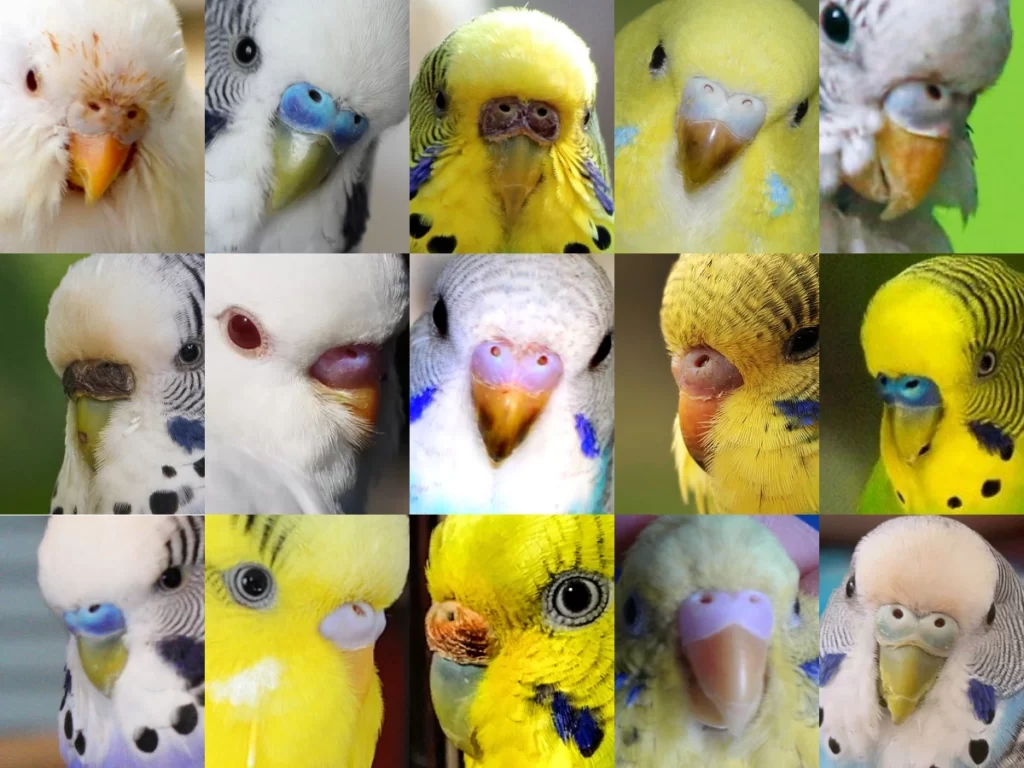
Rose, Purpleish Cere Color
A rose or purplish color cere is typically seen in young male budgies.
This color is common among young birds and signals their transition towards adulthood.
If your budgie displays this color, they are likely a young male.
Whiteish, Light Blue Cere Color
In contrast, a white or light blue cere color often denotes a female budgie.
This color is typical of females that are not in breeding condition.
If your budgie has a cere of this color, they are most likely a non-breeding female.
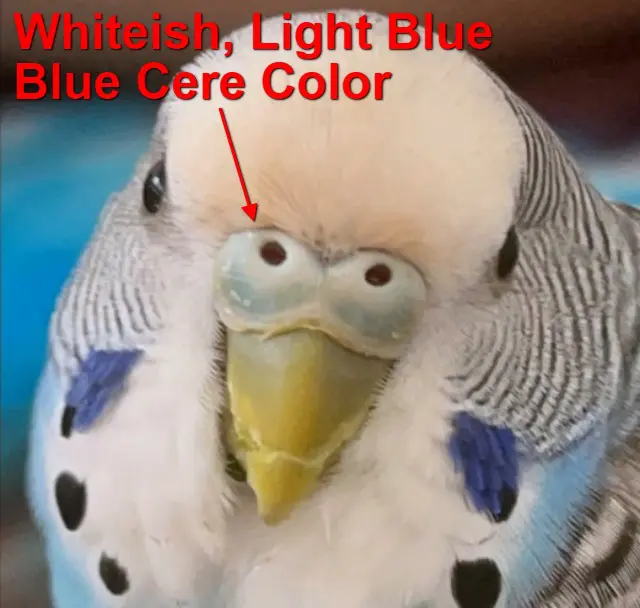
White, Tan, Traces Of Blue Into White
Some budgies, usually females, exhibit a cere that transitions from white to tan, with traces of blue.
This can be a little tricky to identify but is quite common among budgies.
This color change signifies hormonal changes in the budgie, especially if the traces of blue are turning into white.
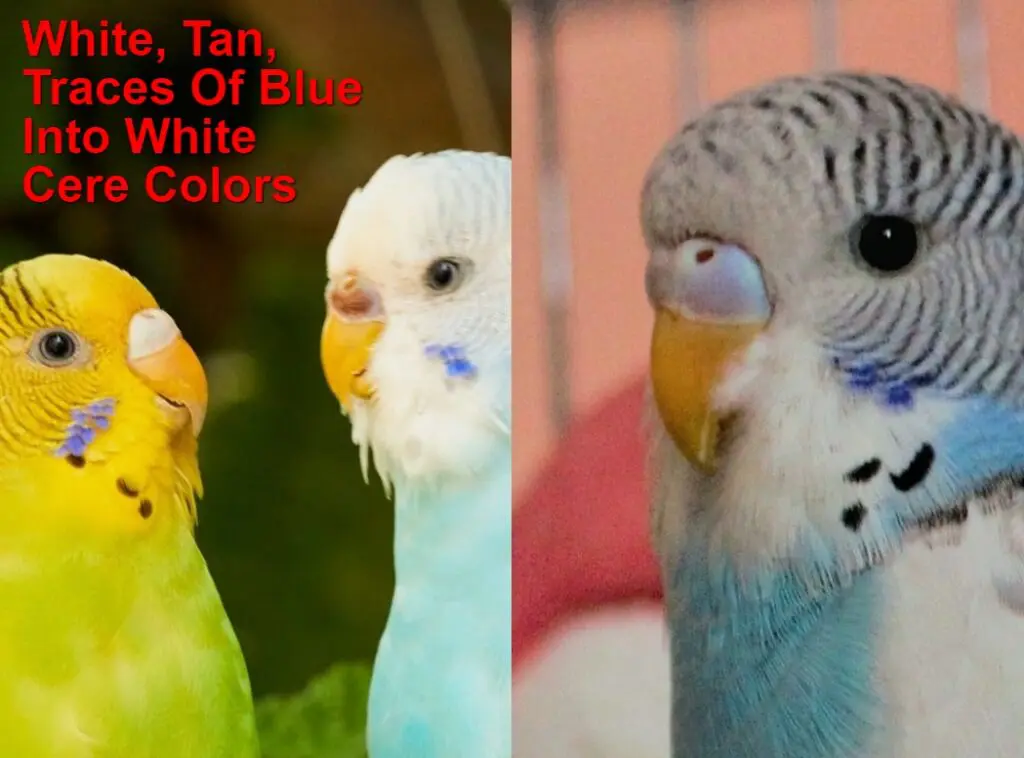
Brighter Blue Cere Color
The cere of a healthy, adult male budgie will often be a brighter blue.
This signifies that the male is in good health and in breeding condition.
If your budgie has a brighter blue cere, they are likely an adult male ready to breed.
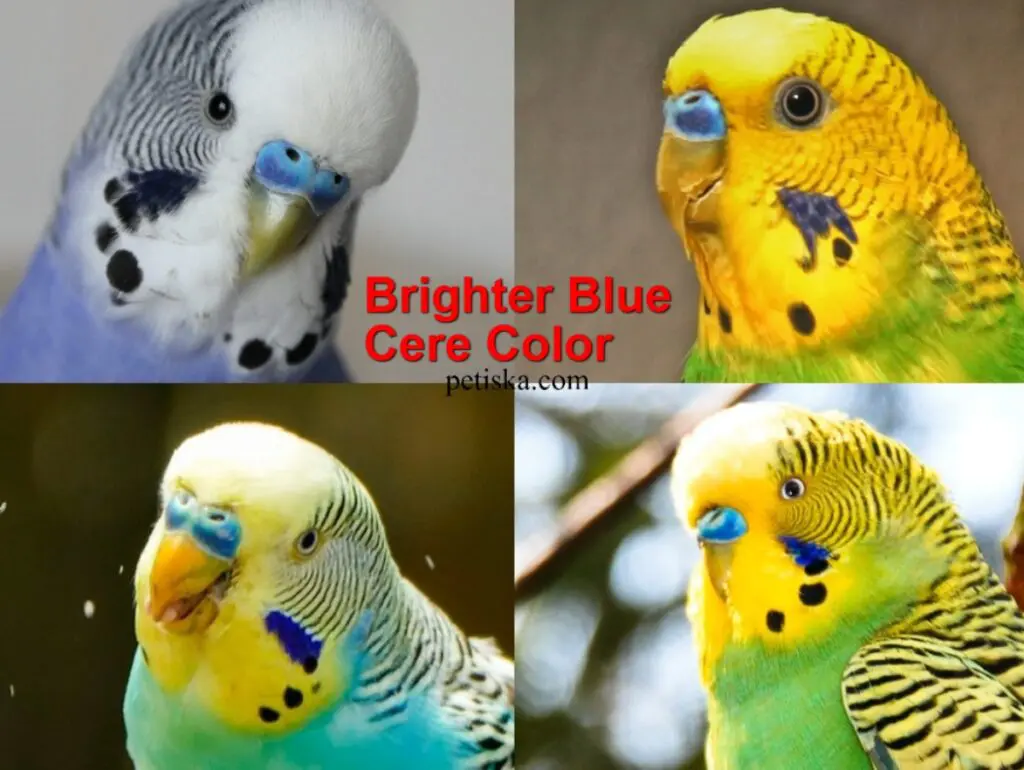
Brown Cere Color
A brown cere can indicate a couple of different things in budgies, depending on the appearance and condition of the cere.
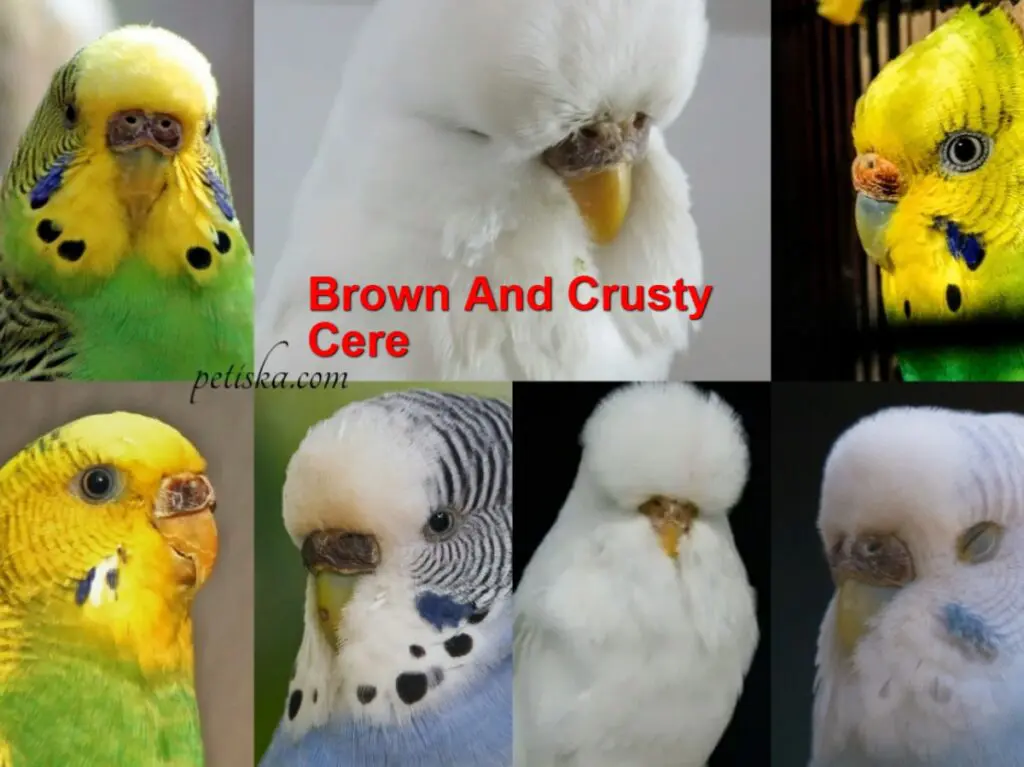
Brown And Crusty Cere In Healthy Female Budgies
In female budgies, a brown cere with a crusty surface is common and indicates the budgie is in breeding condition.
This is a normal occurrence and doesn’t signify any health issues.
Brown And Crusty Cere
A brown and crusty cere usually suggests health issues, and it’s essential to understand the potential causes.
Causes And Conditions
The following conditions can cause a budgie’s cere to become brown and crusty:
Scaly Face Mites
An infestation of scaly face mites can cause the cere to develop a crusty appearance.
These mites burrow into the skin, causing the bird to develop scales on the cere and the surrounding area.
Testicular Tumor
In male budgies, a testicular tumor can result in a change of cere color.
The cere can become brown and crusty due to the hormonal imbalance caused by the tumor.
Hyperestrogenism
This condition, which is characterized by excessive estrogen production, can cause the cere to become brown and crusty in female budgies.
Vitamin A Deficiency
A diet deficient in vitamin A can lead to a crusty brown cere in budgies.
Vitamin A is essential for maintaining healthy skin and feathers.
Brown Cere Hypertrophy
This condition is characterized by an overgrowth of the cere tissue, leading to a brown and crusty appearance.
Dark Or Black Cere Color
A dark or black cere can be an indicator of various health issues, such as malnutrition, injury, hormonal imbalances, or liver problems.
If your budgie has a dark or black cere, it’s recommended to consult a vet to rule out potential health conditions.
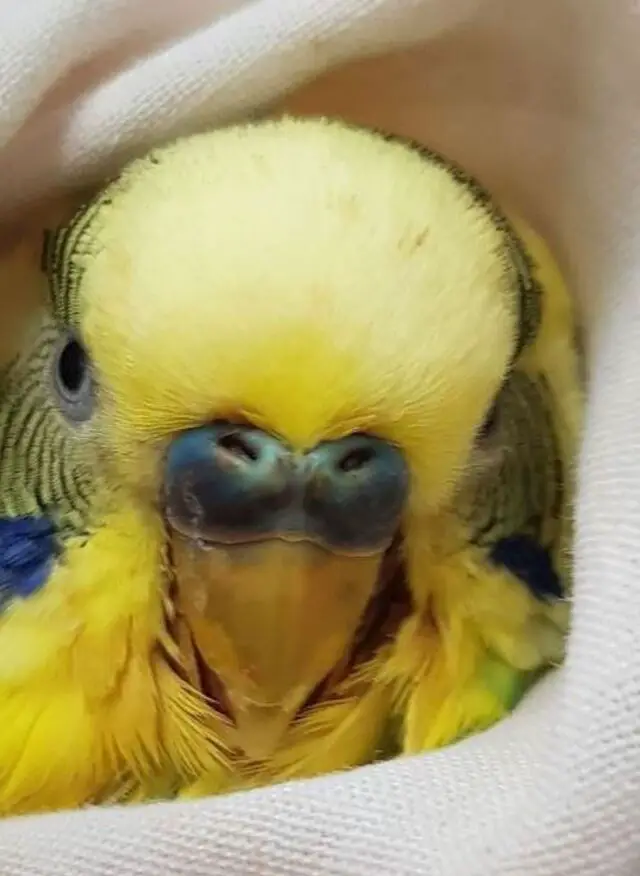
Budgie Cere Colors By Sex And Age
Understanding the correlation between a budgie’s cere color, their sex, and age can help you better care for your budgie.
Let’s break down these associations.
Male Budgie Cere Color
The cere color in a male budgie is typically blue or purplish-blue, indicating they are of breeding age and in good health.
A change in this color could indicate a change in health or hormonal status.
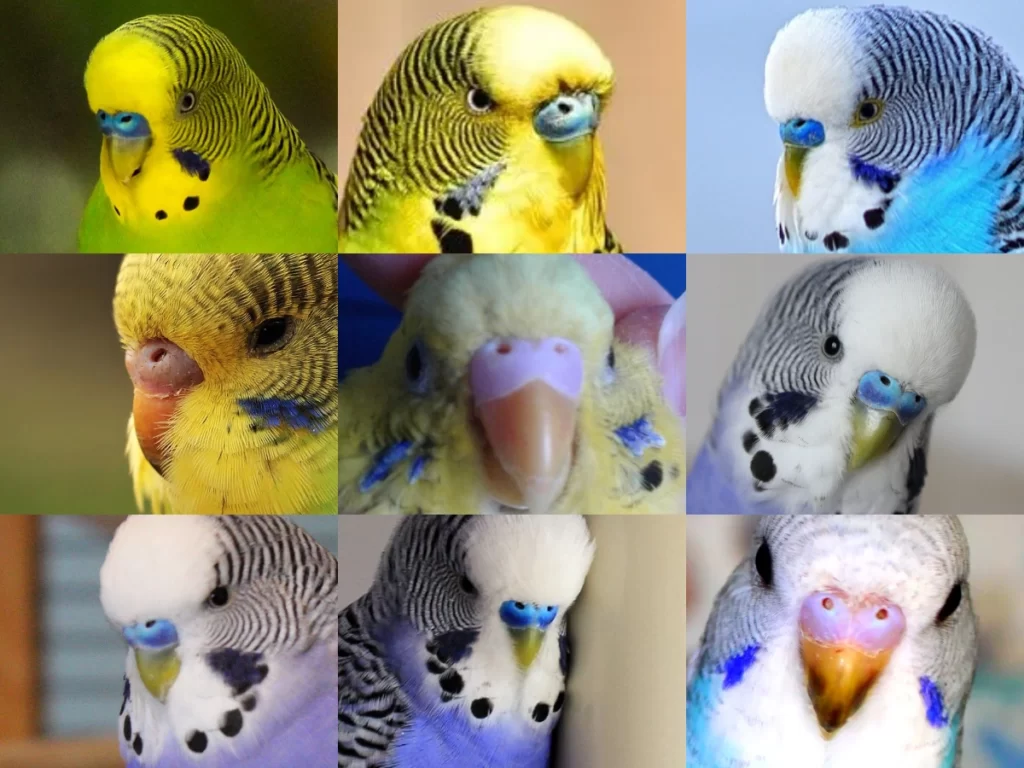
Female Budgie Cere Color
A female budgie usually has a white or brown cere.
When not in breeding condition, the cere is generally white or bluish-white.
During breeding condition, the cere turns a darker brown.
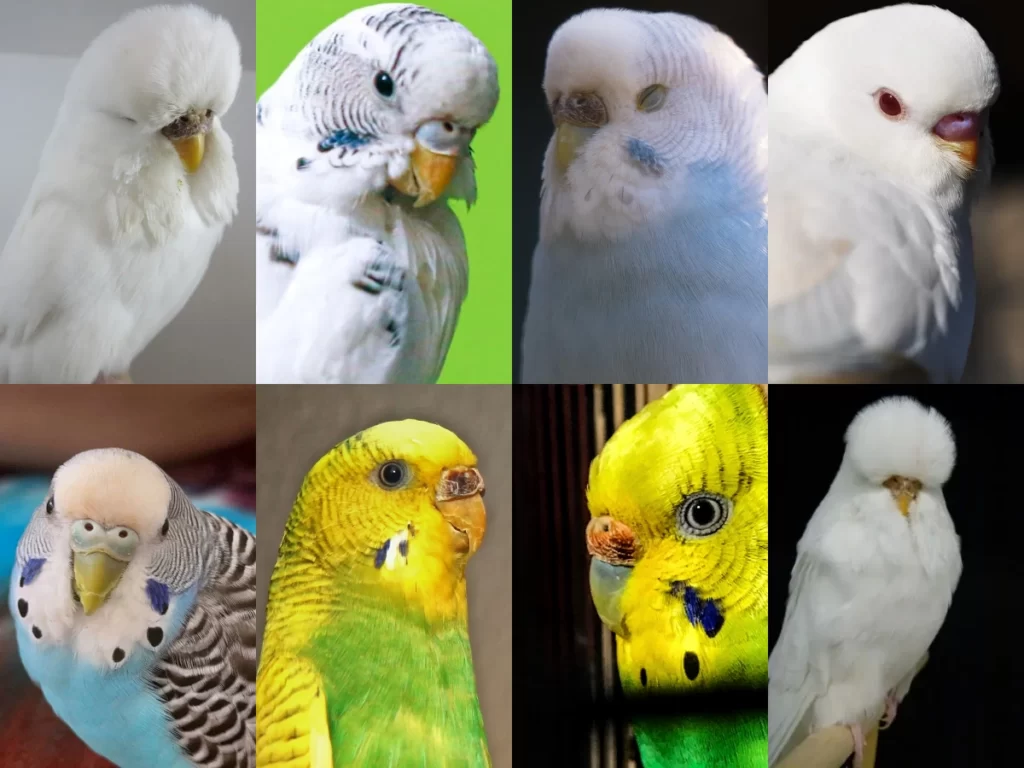
Young Budgie Cere Color
Young budgies, regardless of their sex, typically have a pinkish cere.
This color gradually changes as they reach maturity.
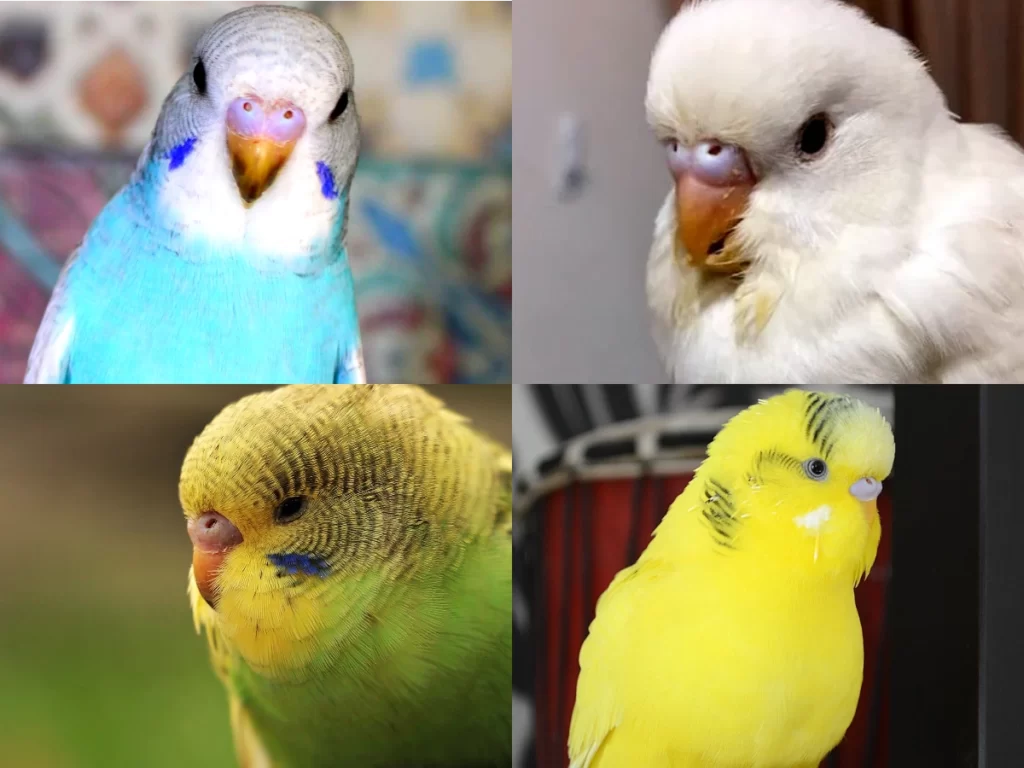
Young Male Budgie Cere Color
In young male budgies, the cere color is often a rosy or purplish hue, signifying their transition to adulthood.
Rose, Purpleish Color
This is the typical color of a young male budgie’s cere.
It signifies that they are on the cusp of maturity and transitioning to an adult.
Young Female Budgie Cere Color
The cere of a young female budgie is generally light blue or whiteish-blue.
This color changes as they reach maturity and prepare for breeding.
Light Blue, Whiteish Blue Color
This light blue or whiteish blue color is common in young female budgies and suggests they are transitioning to adulthood.
Budgie Cere Colors By Transition
The cere color in budgies can also transition due to several factors, including age, health status, and hormonal changes.
White To Brown Cere Color Transition
This is a common transition observed in female budgies.
The cere color changes from white to brown, indicating the budgie is transitioning into breeding condition.
Pinkish To Blueish To Brighter Blue Cere Color Transition
This transition is normal in male budgies throughout their lifetime.
They start with a pinkish cere in their infancy and young adulthood, the cere turns bluish as they mature, and finally, it becomes a brighter blue when they are in breeding condition.
What Are The Factors Affecting The Cere Colors Of Budgies?
Several factors can influence the cere colors of budgies, including their age, sex, genetic makeup, hormonal changes, lighting conditions, health and diet, and any medications or treatments they may be undergoing.
Budgie Cere Colors By Mutations And Mutations Combinations
Budgie cere color can also be affected by various mutations, resulting in colorization patterns that deviate from the norm.
Let’s explore some of these mutations and the corresponding cere colors.
Ino (Albino And Lutino)
The Ino mutation, which includes both albino (white) and lutino (yellow) budgies, typically results in male budgies with a pinkish to purplish-pink cere.
Female budgies with this mutation tend to have a pale blue to white cere, which can turn crusty brown when in breeding condition.
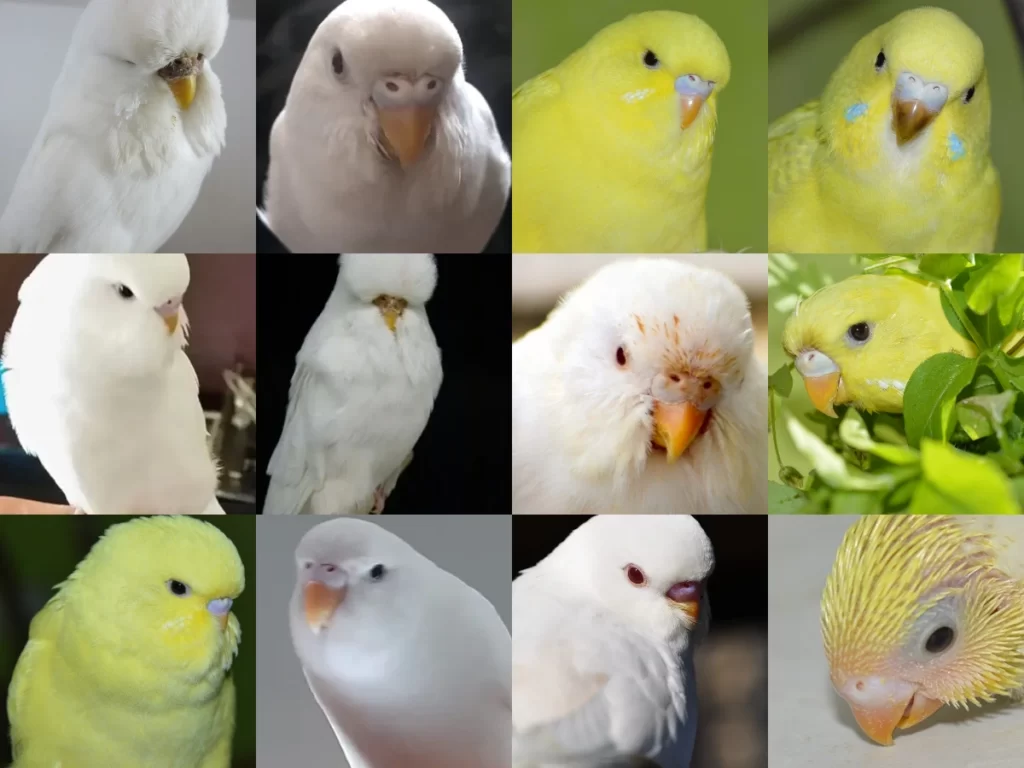
Recessive Pied
In this mutation, male budgies often have pinkish-purple ceres that may not mature to the usual blue color.
Female budgies with this mutation typically have ceres that are tan to brown.
Dominant Pied
The dominant pied mutation often leads to male budgies having patchy blue and pink ceres.
This may eventually turn to the usual blue.
Female budgies with this mutation usually have tan to brown ceres.
Dilute
For budgies with the dilute mutation, males usually have a pinkish-purple cere, and it may not mature to the full blue color.
Females typically have a tan to brown cere.
Clearbody
Male clearbody budgies usually have a fleshy pink to purplish-pink cere.
Females have a pale blue to white cere, which can turn crusty brown when they’re ready to breed.
Dark-eyed Clear
In dark-eyed clear budgies, males typically have a pink cere, while females usually have a whitish or pale blue cere.
Fallows
Fallow budgies, both males, and females, often have pinkish-purple and pale blue to white ceres, respectively.
In females, the cere can turn to a brown color when they’re in breeding condition.
Greywing
Male greywing budgies typically have a fleshy pink to purple cere.
Females have a pale blue to white cere, which can turn crusty brown when in breeding condition.
Faqs
There are often numerous questions concerning the cere colors of budgies.
Below, I’ve addressed some of the most frequently asked ones:
How Do You Tell If Female Budgies Are In Breeding Condition?
Female budgies in breeding condition usually have a brown cere.
However, the cere color can vary depending on the budgie’s mutation.
Why Does My Budgie Have A Crusty Cere?
A crusty cere could indicate several health issues, including mite infestations, tumors, or vitamin deficiencies.
It’s essential to consult a vet if your budgie has a crusty cere.
Do Budgies Shed Their Cere?
No, budgies do not shed their cere.
If you notice peeling or flaking, it could indicate a health problem.
At What Age Does The Budgies’s Cere Begin To Change Color?
A budgie’s cere begins to change color as they reach maturity, usually around 3-4 months of age.
How Can I Tell If My Budgie Is Male Or Female?
You can often determine a budgie’s gender by looking at their cere.
Males typically have a blue cere, while females usually have a white, tan, or brown cere.
How Can I Tell If My Budgie Is Baby, Young Or Adult?
Identifying the age of your budgie can be accomplished by examining their cere color and their behavior.
Baby and young budgies typically have a pinkish or purplish cere, and their behaviors are less defined.
As they transition to adulthood, the cere color changes – to blue in males and brown or tan in females.
Why Is The Cere Of My Budgie Peeling?
The cere of your budgie could be peeling due to various reasons like molting, dry skin, or it could be a sign of health issues like mites or skin infections.
If you notice the cere of your budgie peeling, it’s essential to seek veterinary advice.
What Does It Mean If My Budgie’s Cere Is Changing Color Frequently?
Frequent changes in the cere color can be indicative of hormonal fluctuations, which could be due to health issues, changes in the bird’s environment, or breeding cycles.
If your budgie’s cere color changes frequently, it might be a good idea to consult with a vet to rule out any potential health problems.
Can The Shape Of My Budgie’s Cere Indicate Its Health Condition?
Yes, the shape of your budgie’s cere can give you some clues about their health.
A healthy cere is typically smooth and well-rounded.
If the cere becomes crusty, appears swollen, or has unusual growths, it might indicate health problems such as mites, tumors, or vitamin deficiencies.
Is The Cere Color Of My Budgie Influenced By Its Diet?
The cere color itself may not be directly influenced by the diet, but a balanced, nutritious diet can play a crucial role in maintaining the overall health of your budgie, which indirectly contributes to a healthy cere.
A poor diet can lead to health issues, which may result in changes in cere color or texture.
Why Does My Female Budgie Have A Blue, Purple Cere?
A blue or purple cere in a female budgie could be due to various reasons:
Testosterone Levels
An increase in testosterone levels can cause a change in cere color in female budgies.
Hormone Imbalance
Hormonal imbalances can also lead to a change in cere color in female budgies.
Mutations
Certain mutations can cause a deviation in the usual cere color patterns.
Why Is The Cere Of My Budgie Turning Brown And Crusty?
The cere of your budgie could be turning brown and crusty due to several reasons:
Scaly Face Mites
Scaly face mites can cause the cere of your budgie to turn brown and crusty.
Testicular Malignancy
Testicular malignancies or tumors can cause hormonal imbalances, leading to changes in cere color and texture.
At What Age Can You Tell A Budgies Gender?
Usually, by the time a budgie is 3-4 months old, you can identify its gender by observing the color of the cere.
Male budgies typically have a blue cere, while female budgies have a white, tan, or brown cere.
However, the color can vary depending on the budgie’s mutation.
With an understanding of the meaning behind your budgie’s cere color, you’ll be better equipped to provide the care and attention your pet needs.
Always be observant of any changes in the cere’s color or texture, as it could be a sign of underlying health issues.
Sources:
![Why is my budgie’s cere turning brown? [MALE & FEMALE]](https://www.petiska.com/wp-content/uploads/2022/03/why-is-my-budgies-cere-turning-brown-male-female-1646851856-400x300.jpg)

